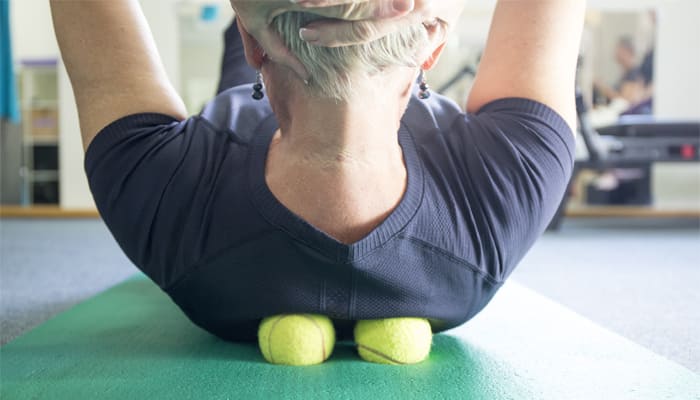
7 Tips for Back Pain Relief
Published: November 2020
Back pain is one of life’s most common health issues, something almost everyone will deal with at least once in their life. Unfortunately, many of us experience back pain much more often than once! According to the National Institutes of Health, lower back pain is the number one cause of job-related disability.1
There are many causes of back pain, including strains, herniated discs and injury. Certain individuals are also more prone to having back pain because of a genetic component—particularly those with structural deformations such as spine curvature or ankylosing spondylitis.2
However, you might experience back pain due to your lifestyle—sitting too much, especially if you have a desk job, poor posture and weak supporting muscles can all take their toll.
In desperation for relief, you might visit various specialists, or purchase ergonomically designed chairs/supports that cost a pretty penny. These strategies are successful for some people, but not everyone has the time and/or money to go to such lengths.
If you’re experiencing back pain, don’t let it get you down: You can feel better! Here are some simple and natural ways to find relief on your own:

1. Improve your posture
Poor posture is a pain in the neck – literally! Don’t let yourself slouch or slump. Maintaining good posture — standing and sitting up straight — reduces the pressure on your nerves and can help relieve the pain. A good strategy to practice while you’re going through each day is to try to keep your abdominal muscles contracted and tight; this should automatically cause you to sit or stand up straight.

2. Exercise regularly
When people have sore backs, they tend to avoid activity, and this just makes it even worse! Find activities that don’t aggravate the pain, such as low-impact activities like biking, water aerobics, etc.
One of the causes of back pain is being overweight. Exercise can help you maintain a healthy weight, while increasing your strength and flexibility.

3. Strengthen your core
Remember, your abdominal muscles and obliques are the muscles that stabilize your core. When they are weak, it causes poor posture, which results in back pain.
Strengthening these muscles can help improve your posture and decrease pressure on your back. There are many core-strengthening exercises in addition to the traditional sit-ups, such as planks and bridges.

4. Stretch out the pain
It’s not just stretching your back that’s important. Many times, a sore back is linked to other muscles that are tight, such as your hamstrings or hip flexors. The American College of Sports Medicine recommends that adults do flexibility exercises at least two or three days a week.3
Each stretch should be held for 10–30 seconds, to the point of tightness or slight discomfort, but not to the point of pain. Stretching can reduce back stiffness.

5. Support your knees while you sleep
Different sleeping positions put added pressure on the back. To help lessen this effect, sleep with an extra pillow to support your knees. If you sleep on your back, put a pillow under your knees. If you sleep on your side, put a pillow between your knees. Try to limit sleeping on your stomach.

6. Practice self-massage
While it’s nice to have a professional massage every now and then, they can get expensive. You can ask a family member to rub your back muscles, or even try to massage yourself—you might be surprised by the difference it makes!
In addition to using your hands, you can use a tennis ball, frozen water bottle, foam roller or baseball bat wrapped in towels, which you should roll along your back while pressed against the floor.
Cold and heat therapy can also be beneficial, so try alternating with hot and cold packs while you’re watching TV or reading.

7. Eat the best foods for back pain
In addition to eating a balanced diet rich in vegetables, lean protein and whole grains, you may benefit from inflammation-modulating nutrients, such as fish oil, bromelain and curcumin.
Keeping inflammation in check is key, since this problem is the root of nearly all health problems — especially back pain.
Other ingredients that might help support pain relief are those that can provide nerve support and discomfort relief, such as PEA (palmitoylethanolamide) and honokiol. PEA is a fascinating fatty acid that can inhibit inflammatory factors and help inhibit occasional discomfort.4 Honokiol supports calming receptors in your brain, affecting how you perceive discomfort.5-7
These seven steps might not eliminate all pain from your life, but they should help you find some relief for your sore back and get you back on track to optimum health.
References:
- https://www.nih.gov/news-events/news-releases/chronic-low-back-pain-research-standards-announced-nih-task-force
- http://www.ninds.nih.gov/disorders/backpain/detail_backpain.htm
- Morey, SS. ACSM Revises Guidelines for Exercise to Maintain Fitness. Am Fam Physician. 1999 Jan 15;59(2):473.
- Pain Physician. 2016;19(2):11-24.
- Adv Pharmacol. 2006;54:1-27.
- Neuropharmacology. 2012;62(8):2507-14.
- Neurochem Res. 1999;24(12):1593-602.
Always be in the know!
Access the latest deals, wellness news, expert health tips & more!



